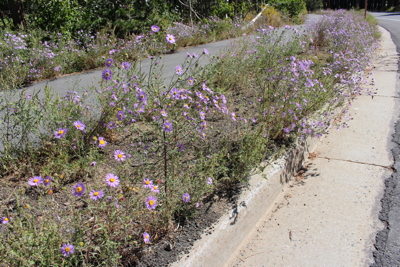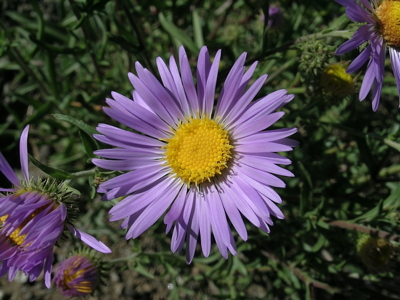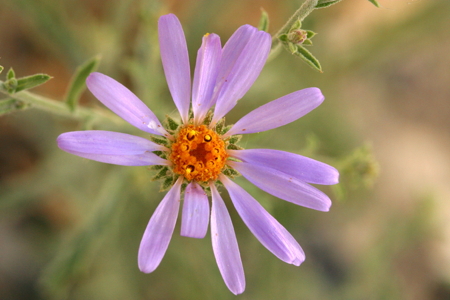A Non-native Invasive “Aster” is Spreading Throughout the Town of Mammoth, Threatening Local Habitats and Native Plants
PRESS RELEASE: September 9, 2014
Invasive non-native Dieteria invading a disturbed area on Meridian Blvd in Mammoth Lakes - photo by Sherry Taylor
A non-native invasive “aster” from Wyoming is spreading aggressively throughout the Town of Mammoth. Ann Howald, a well-respected botanist who has studied Mono County’s native plants for more than 40 years, believes it will cross pollinate with native “asters” and could become a “super weed” with the potential to invade the wild landscapes surrounding the town. She has been invited to present a paper on this topic at the California Native Plant Society’s Conservation Conference in January 2015.
Dan Dawson (Director of the Valentine Eastern Sierra Reserve) and the Forest Service botanist are also aware of the plant and watching the situation closely. Dan is particularly concerned about the plant spreading into Valentine Camp, where the protection of native biodiversity is a primary goal.
Three years ago the invasive “aster” was found mainly along upper Meridian Boulevard and at Cerro Coso College. At the college, it was weeded out (a dumpster load) as part of an on-going habitat restoration project. Now the invasive “aster” can be found everywhere in the community in spite of a low precipitation year. It is important to get rid of this plant in the next two weeks before it goes to seed and we are asking for your help. The best way to remove it is to pull it and place it in a sealed trash bag and dispose of it as trash. If you need more information or help with other ways to remove contact Ann Howald at annhowald@vom.com
Invasive non-native Dieteria on the left (photo by Steven Perry), compared to our native Dieteria on the right (photo by Steve Matson).
For more information, read the article in the April-June 2014 CNPS Bulletin (vol. 44, no. 2), text below:
New Invasive Aster in Mammoth Lakes
COULD HYBRIDIZE WITH LOCAL NATIVE SPECIES TO CREATE A “SUPER WEED”
In late summer 2012 Bristlecone Chapter members noticed that a non- native “aster” was taking over a recently restored native landscape at the Cerro Coso College campus on the outskirts of the town of Mammoth Lakes. Taking immediate action to limit the plant’s spread at the college and into adjacent native vegetation, volunteers, led by Sherry Taylor—a long- term resident of Mammoth Lakes and coordinator of the Bristlecone Chapter’s Mammoth area plant sale—hand-pulled a dumpster-sized quantity of the invader.
Surveying other parts of Mammoth Lakes, Sherry noticed that the same plant had invaded roadsides and pockets of native sagebrush scrub. These areas included a ridge adjacent to the University of California’s Valentine Camp in Old Mammoth. Fearing that the invasive plant could spread to Valentine Camp, a University of California (UC) Natural Reserve established to protect its natural habitats and native species, Sherry contacted Daniel Dawson, the reserve’s resident director. Since all of UC’s Natural Reserves have a mandate to protect native biodiversity, Dan alerted Valentine Camp’s volunteer botanist and Bristlecone Chapter member Ann Howald.
Ann recognized the invasive aster as a likely member of the genus Dieteria (formerly Machaeranthera). Species in this genus are known commonly as tansy aster, hoary aster, Dieter’s aster, and by other names. This was further cause for alarm, since Valentine Camp, the entire Mammoth Lakes region, and much of the Eastern Sierra support varieties of the native plant Dieteria canescens, or hoary aster. The concern was that a closely related non-native species of Dieteria could hybridize with the local native varieties of Dieteria canescens. Hybrids between natives and non-natives have the potential to become “super weeds” capable of outcompeting native species, not to mention confounding future taxonomists.
Those of us who loved the simple and easy-to-pronounce name “aster” have had to become aware that the most recent classification systems in The Jepson Manual, Second Edition, and the Flora of North America, do not include any members of the genus Aster as native to California. Aster has been relegated to the status of a common name for species now included in genera such as Dieteria, Symphyotrichum, Oreostemma, and the like.
Identifying an invasive plant can be a challenge, since its native habitat and range aren’t immediately clear, and it may be a plant from the horticulture trade that is an unusual variant of a native species, or even a hybrid form. Ann collected voucher specimens of the invader, reviewed their characteristics, and used the extensive collection of Dieteria specimens at Rancho Santa Ana Botanic Garden Herbarium in an attempt to narrow the invasive Dieteria’s identity. A specimen of the plant was sent to Dr. Ronald Hartman, curator of the Rocky Mountain Herbarium at the University of Wyoming in Laramie, and an expert on the genus Dieteria. Dr. Hartman identified the invader as Dieteria canescens var. canescens, a surprising and confusing result because this is the same variety of Dieteria canescens that is native to the Mammoth Lakes area.
Dr. Hartman explained that the plants invading Mammoth Lakes are native to western Wyoming and the Great Basin, but not to California. Variety canescens is the most widespread and diverse of all ten varieties of Dieteria canescens, which explains how the invader can look so different from the native, even though they are the same variety. The invader is an annual or biennial, has many large flowering heads with dark purple rays, and branches profusely from the upper stems. The native is a semi-woody short-lived perennial, has fewer, smaller heads with light purple rays, and branches mainly from the base. Similar phyllaries (bracts at the base of the flower heads), stem hairs, and seeds are what unite these very different looking plants into the same variety of Dieteria canescens.
In 2013 the invasive Dieteria was found throughout Mammoth Lakes, in spite of low rainfall. Ann surveyed Valentine Camp and adjacent habitat areas and found no trace of the plant—at least not yet, although she observed it within a quarter-mile of Valentine Camp. Additional plants were pulled by Sherry and others at Cerro Coso College. They found fewer than in 2012.
Plans for 2014 include a more comprehensive effort to contain the plant’s spread within the town of Mammoth Lakes, and surveys in the Mammoth Lakes Basin and on Mammoth Mountain to determine whether it has spread beyond the town.
Ann Howald is a retired botanist with a special interest in invasive plants, and has been studying the flora of Mono County for many years. Sherry Taylor is an outdoor science teacher at the Valentine Reserve, and coordinated a student restoration project at Cerro Coso College through a grant from the Bristlecone Chapter.


